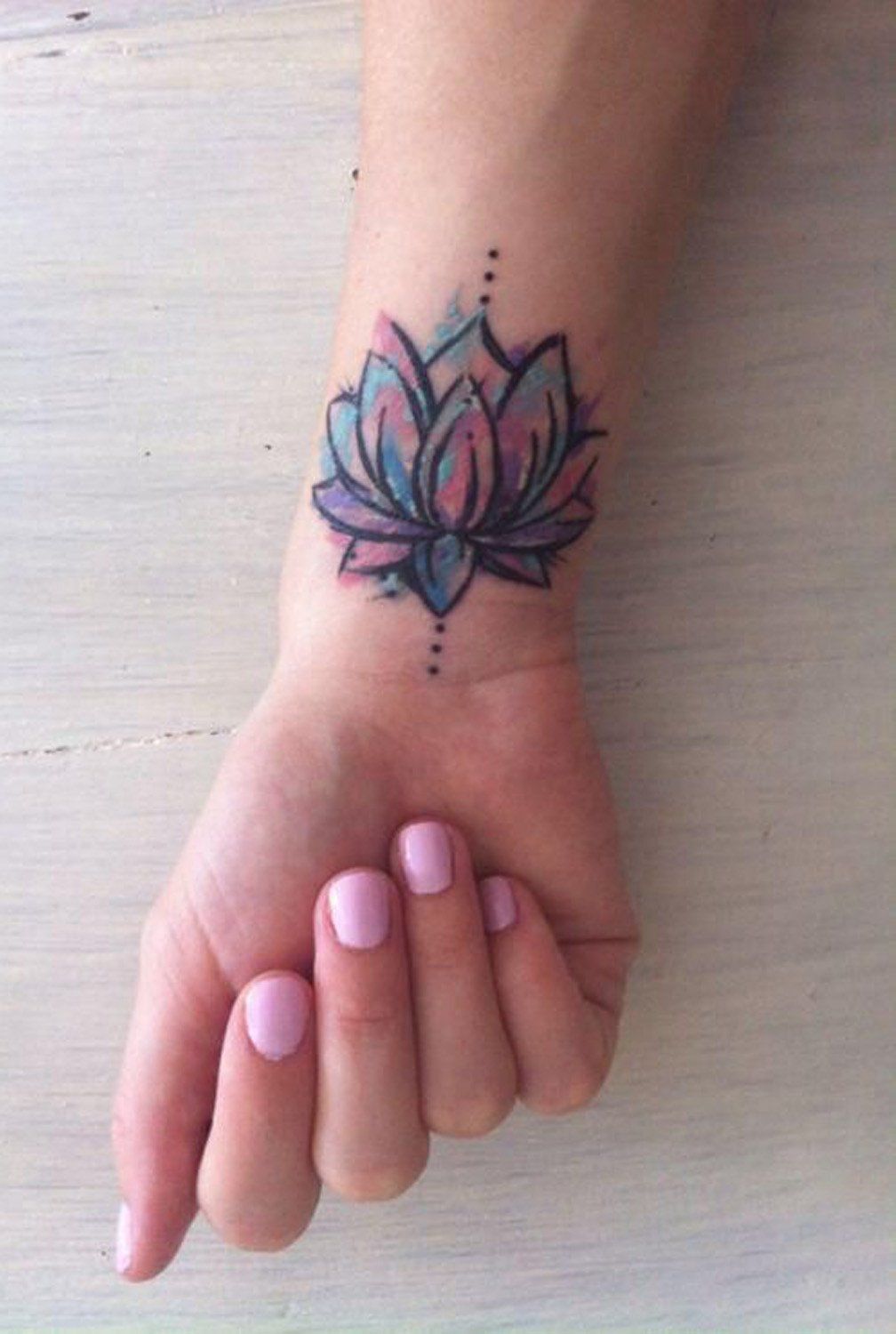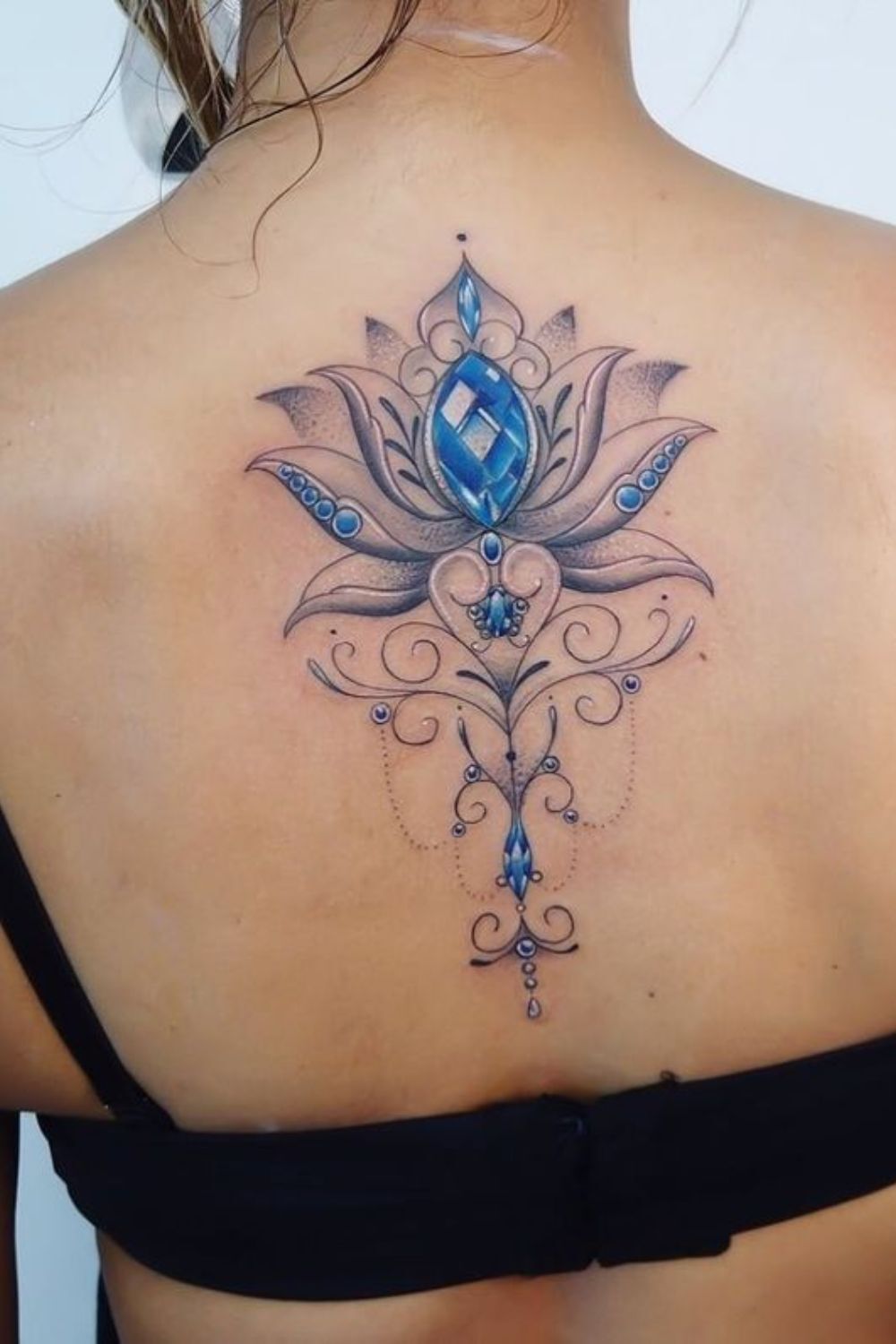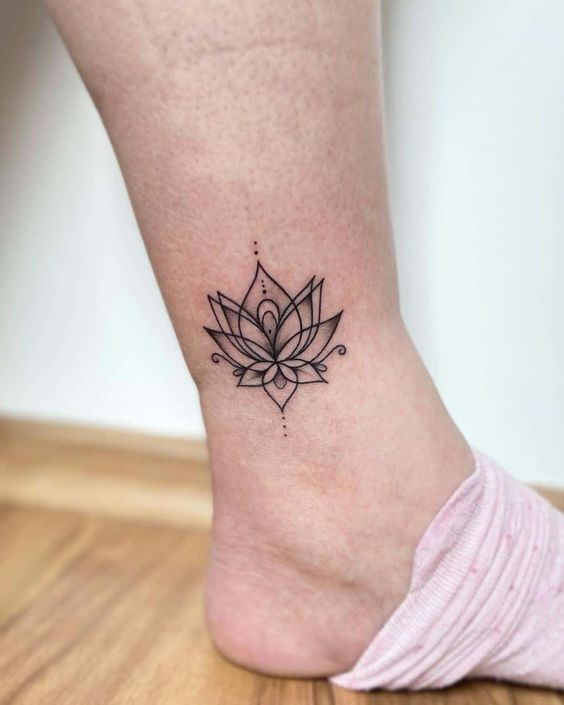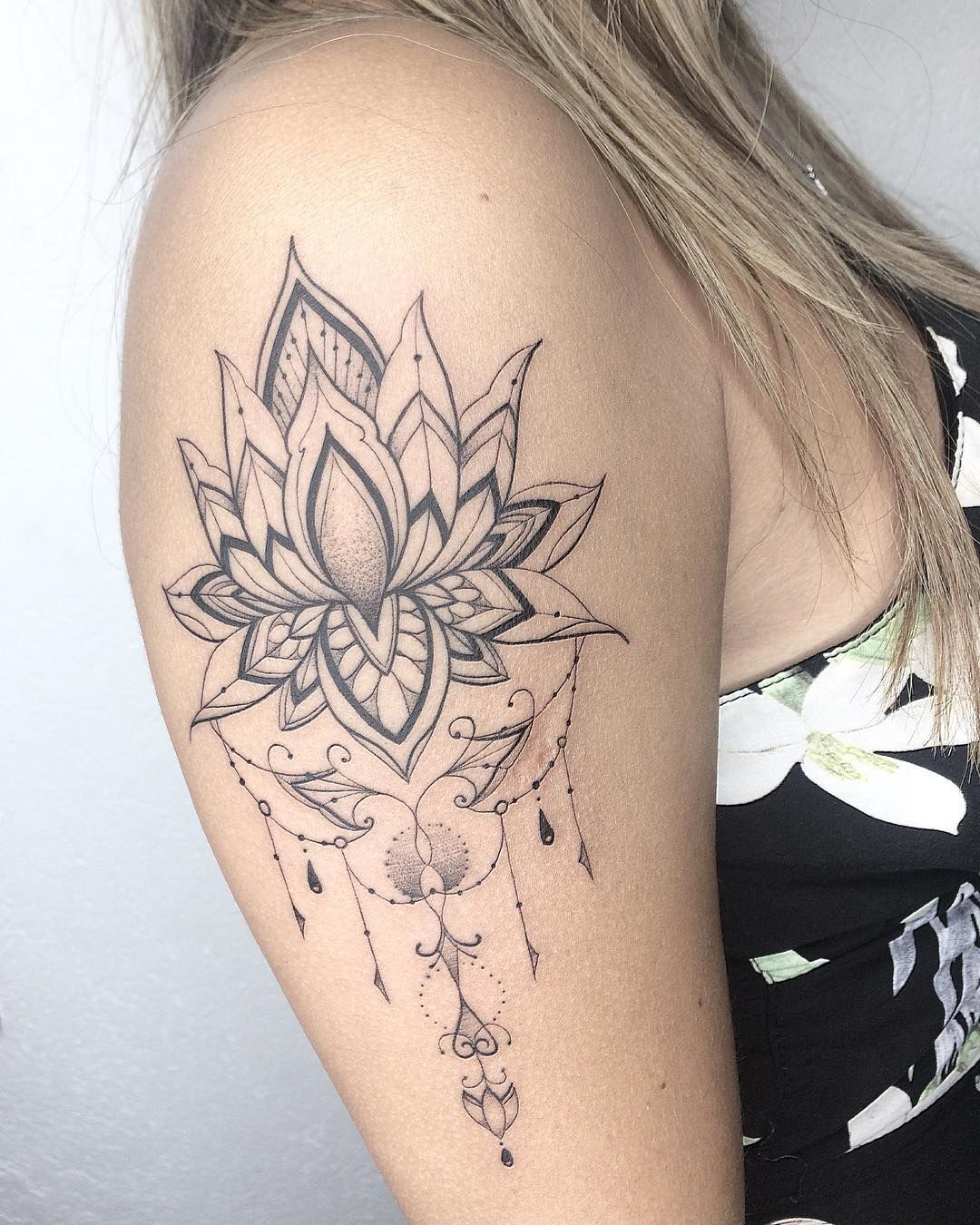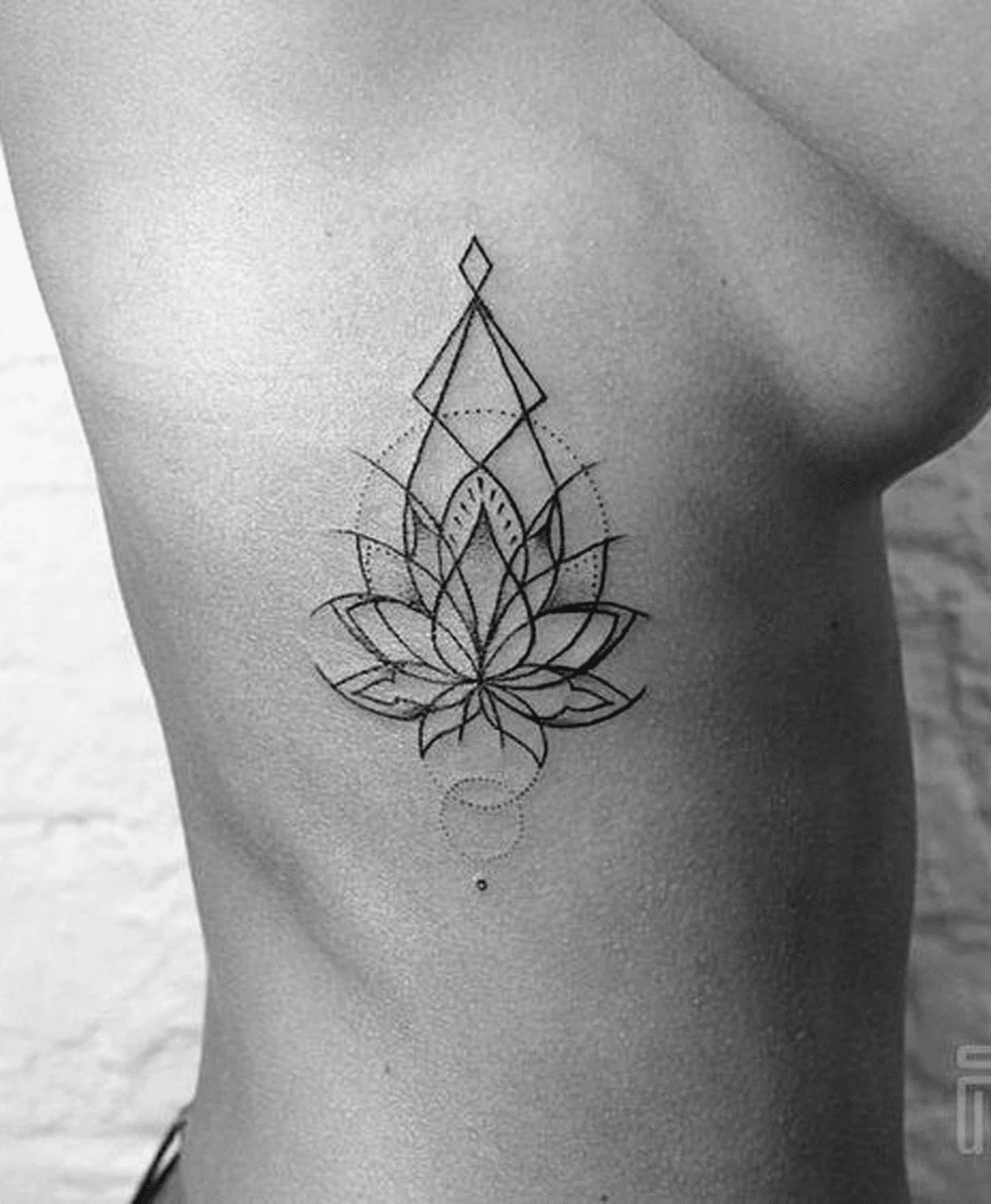The lotus flower symbolizes beauty, purity, and enlightenment, making it a popular choice for tattoos. These tattoos can be simple or detailed and can be placed anywhere on the body. This article will explore the symbolism, meaning, and history behind lotus flower tattoos, as well as some popular design ideas and who should consider getting one.
Are you only interested in tattoo designs and want to skip the educational part?
No problem, we got you covered! Click HERE to get inspired.
What Is The Meaning Behind Lotus Flower Tattoos?
Lotus flower tattoos symbolize personal growth, transformation, and the ability to overcome challenges, inspired by the flower's growth from muddy waters into a beautiful blossom. They hold various meanings in different cultures.
In Buddhism and Hinduism, they represent purity and divine grace. In Egyptian mythology, they symbolize rebirth, while in Chinese and Japanese cultures, they signify enlightenment and purity.
The color of the lotus in the tattoo can also alter its meaning, such as red for love, blue for wisdom, and white for spiritual perfection.
The symbolism of the lotus flower tattoo can therefore be deeply personal, depending on the wearer's interpretation of this versatile symbol.
What Does The Lotus Flower Symbolize in different cultures?
The lotus flower holds significant symbolism in various cultures around the world. Let's explore its meaning in different cultural contexts, with a focus on the lotus flower and lotus flower tattoos:
Hinduism: In Hinduism, the lotus flower holds immense importance. It is associated with deities such as Vishnu and Lakshmi and represents divine beauty, purity, and transcendence. The unfolding of its petals symbolizes the expansion of the soul and spiritual awakening.
Buddhism: The lotus flower is highly revered in Buddhism and is considered one of the Eight Auspicious Symbols. It represents purity, spiritual enlightenment, and the ability to rise above earthly temptations. The lotus is often depicted in Buddhist art, with different colors and stages of blooming signifying various aspects of spiritual growth.
Ancient Egypt: In ancient Egyptian mythology, the lotus flower symbolizes creation, rebirth, and the Sun. It is associated with the sun god, Atum-Ra, who was believed to have risen from a lotus that emerged from the primordial waters. The lotus also represents purity and resurrection in the afterlife.
Chinese Culture: The lotus flower is highly regarded in Chinese culture and is seen as a symbol of purity, harmony, and beauty. It is often associated with the Buddhist concept of enlightenment and is a popular subject in Chinese art, literature, and poetry.
Japanese Culture: In Japan, the lotus flower holds significance in both Buddhism and Shintoism. It is admired for its pure beauty and is often depicted in Japanese art, including traditional paintings and tattoos. The lotus symbolizes enlightenment, perseverance, and spiritual growth.
best lotus flower tattoo placement ideas and their meanings
Lotus flower tattoos can be placed on different parts of the body, and each placement carries its own symbolism and aesthetic appeal. Here are five highly rated lotus flower tattoo placement ideas and their associated meanings:
Wrist Placement lotus tattoo
A lotus flower tattoo on the wrist is a popular choice due to its visibility and versatility. It symbolizes mindfulness, spirituality, and constant growth. This placement serves as a reminder to stay present, embrace change, and strive for personal and spiritual development.
Back Placement lotus tattoo
Placing a lotus flower tattoo on the back allows for a larger and more intricate design. It signifies strength, resilience, and the ability to rise above challenges. The back placement is also associated with the idea of carrying the weight of past experiences while moving forward with grace and determination.
Ankle Placement lotus tattoo
The ankle is a delicate and feminine placement for a lotus flower tattoo. It represents balance, stability, and grounding. The lotus on the ankle symbolizes the connection between the spiritual and physical realms, reminding the wearer to stay grounded while pursuing their spiritual journey.
Shoulder Placement lotus tattoo
Lotus flower tattoos on the shoulder can be easily displayed or concealed depending on the clothing worn. This placement signifies grace, beauty, and femininity. It can also represent protection, as the shoulders are seen as a place where burdens are carried, and the lotus acts as a shield against negative energies.
Rib Placement lotus tattoo
A lotus flower tattoo on the ribcage is often chosen for its sensual and alluring appeal. It symbolizes inner strength, growth, and transformation. The rib placement represents the blossoming of the lotus from the depths of one's being, reminding the wearer of their resilience and ability to overcome challenges.
Who should get a lotus flower tattoo?
A lotus flower tattoo is a versatile and meaningful choice that can resonate with a wide range of individuals. Here are some characteristics of people who might consider getting a lotus flower tattoo:
Spiritual Seekers: Lotus flower tattoos are often chosen by individuals who are on a spiritual journey or seeking personal growth and enlightenment. If you resonate with spiritual or philosophical teachings, the lotus flower can serve as a visual representation of your aspirations and beliefs.
Symbolic Meaning Seekers: Those who appreciate the symbolism behind tattoos may find the lotus flower appealing. If you are drawn to concepts such as rebirth, resilience, purity, beauty, and personal transformation, a lotus flower tattoo can be a powerful expression of these ideas.
Individuals Embracing Change: The lotus flower's growth from muddy waters to a beautiful bloom represents the ability to overcome challenges and embrace change. If you are going through a period of transformation, healing, or starting a new chapter in your life, a lotus flower tattoo can symbolize your journey of growth and resilience.
Those Seeking Inner Peace: The lotus flower is often associated with inner peace, tranquility, and harmony. If you strive for a state of calmness and balance in your life, a lotus flower tattoo can act as a reminder to stay centered and grounded amidst the chaos of the world.
Aesthetic Appreciators: Beyond the symbolism, lotus flower tattoos are visually captivating and aesthetically pleasing. If you are attracted to the beauty, elegance, and intricate details of the lotus flower, a tattoo featuring this motif can be a way to adorn your body with a design that resonates with your sense of aesthetics.
General Breakdown Of Tattoo Pain Levels On Different Body Parts
Here is a breakdown of the different tattoo pain levels:
- Low: This level of pain is generally described as a mild discomfort or tickling sensation. It is similar to the sensation of getting a light scratch or scrape.
- Moderate: This level of pain is generally described as a moderate discomfort or aching sensation. It is similar to the sensation of getting a deep scratch or scrape or being pinched.
- High: This level of pain is generally described as a strong discomfort or throbbing sensation. It is similar to the sensation of getting a burn or being stung by a bee.
It's important to note that pain tolerance is highly individual and can vary greatly from person to person. Some people may find certain body parts more or less painful than others, and the same body part can be more or less painful for different people. Additionally, the level of pain can be affected by factors such as the size and location of the tattoo, the skill of the tattoo artist, and the individual's own pain threshold.
Tattoo placement pain level chart
Body Part | Pain Level | Explanation |
Forehead | Low | The forehead has few nerve endings, so it is not a particularly painful area. |
Eyebrows | Low | The eyebrows have few nerve endings, so the pain level is relatively low. |
Ear | Low | The ear is a relatively thin and fleshy area, so the pain level is low. |
Nostril | Low | The nostril is a small area with thin skin, so the pain level is low. |
Lip | Low to Moderate | The lip has more nerve endings than some other areas, so it may be slightly more painful. |
Cheek | Low to Moderate | The cheek has a moderate amount of nerve endings, so it may be slightly more painful. |
Moderate | The neck has a moderate amount of nerve endings, so it may be slightly more painful. | |
Moderate to High | The chest has a high concentration of nerve endings, so it can be quite painful. | |
Abdomen | High | The abdomen has a high concentration of nerve endings, so it can be quite painful. |
Back | High | The back has a high concentration of nerve endings, so it can be quite painful. |
Shoulders | High | The shoulders have a high concentration of nerve endings, so they can be quite painful. |
Upper Arms | Moderate to High | The upper arms have a moderate to high concentration of nerve endings, so they can be somewhat painful. |
Elbows | High | The elbows have a high concentration of nerve endings, so they can be quite painful. |
Forearms | Moderate | The forearms have a moderate concentration of nerve endings, so they are not as painful as some other areas. |
Hands | High | The hands have a high concentration of nerve endings, so they can be quite painful. |
Lower Arms | Low to Moderate | The lower arms have a lower concentration of nerve endings, so they are not as painful as some other areas. |
Wrists | Low | The wrists have a low concentration of nerve endings, so they are not very painful. |
Lower Back | High | The lower back has a high concentration of nerve endings, so it can be quite painful. |
Buttocks | High | The buttocks have a high concentration of nerve endings, so they can be quite painful. |
Thighs | High | The thighs have a high concentration of nerve endings, so they can be quite painful. |
Knees | High | The knees have a high concentration of nerve endings, so they can be quite painful. |
Calves | Low to Moderate | The calves have a low to moderate concentration of nerve endings, so they are not as painful as some other areas. |
Ankles | Low | The ankles have a low concentration of nerve endings, so they are not very painful. |
Tattoo aftercare tips
Before getting a tattoo:
Choose a reputable tattoo artist and parlor. Research the artist's portfolio and read reviews from previous clients.
Consult with the artist about the design and placement of the tattoo.
Make sure you are in good health. If you have any medical conditions or are taking any medications that may affect your ability to heal, be sure to let your tattoo artist know.
Consider using a numbing cream to reduce pain during the tattooing process. These creams contain a numbing agent (such as lidocaine) that can be applied to the skin before the tattoo is done. It's important to follow the instructions on the numbing cream and to only use it as directed.
Avoid alcohol, caffeine, and other substances that can thin your blood for at least 24 hours before getting a tattoo.
Eat a healthy meal before your tattoo session to ensure that your blood sugar is stable.
Wear loose, comfortable clothing that allows easy access to the area being tattooed.
After getting a tattoo:
Follow the aftercare instructions provided by your tattoo artist. These may include:
Keeping the tattoo clean and covered with a bandage for the first few hours after getting tattooed.
Washing the tattoo with lukewarm water and a mild soap (such as unscented, antimicrobial soap) and patting it dry with a clean towel.
Applying a thin layer of tattoo ointment or lotion (such as A&D or Aquaphor) to the tattoo and covering it with a clean bandage or wrap.
Repeating this process for the first few days, or until the tattoo has fully scabbed over.
Avoid soaking the tattoo in water for the first week, such as in a bath or pool.
Avoid picking or scratching at the scabs, as this can cause the tattoo to fade or become infected.
Avoid exposure to direct sunlight or tanning beds for at least 2-4 weeks.
If you experience any redness, swelling, or unusual discharge, contact your tattoo artist or a healthcare professional.
Overall, it's important to keep your tattoo clean and moisturized during the healing process to ensure that it heals properly and looks its best. Using a numbing cream can help reduce pain during the tattooing process, but it's important to use it as directed and to follow all aftercare instructions to ensure that your tattoo heals properly.
People Also Ask:
What does a lotus flower tattoo represent?
A lotus flower tattoo can represent spiritual awakening and enlightenment, purity, detachment, and the ability to rise above difficult situations.
What is the symbolism of a lotus flower tattoo?
The symbolism of a lotus flower tattoo can include spiritual awakening and enlightenment, purity, detachment, and the ability to rise above difficult situations.
Where should I place a lotus flower tattoo?
A lotus flower tattoo can be placed anywhere on the body, depending on the size and design of the tattoo. Some popular locations include the wrist, back, and ankle.
What colors should I use for a lotus flower tattoo?
A lotus flower tattoo can be done in various colors, but traditional colors include pink, purple, and blue. Some people prefer black and gray for a more minimalist look.
Can men get a lotus flower tattoo?
Yes, both men and women can get a lotus flower tattoo. The design and placement of the tattoo can be customized to suit the individual's style and preferences.
Watch A video of a lotus flower tattoo done by a pro
175+ lotus flower tattoo Ideas For Your Inspiration
Final thoughts
Lotus flower tattoos are a beautiful and meaningful way to express one's spiritual journey and connection to Eastern cultures. With so many design options available, there is a lotus flower tattoo for everyone. Whether you're looking for a simple and minimalist design or a more detailed and intricate tattoo, the lotus flower can symbolize spiritual growth and enlightenment.

